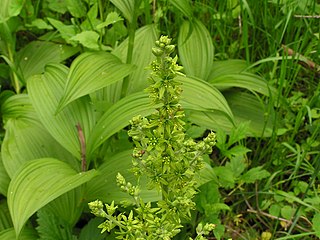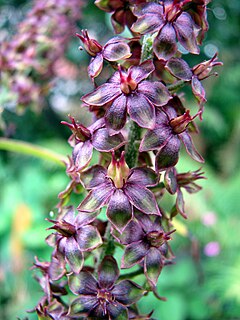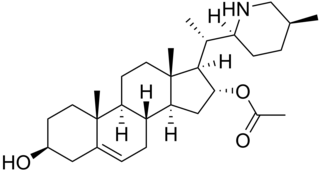
Melanthieae is a tribe of flowering plants within the family Melanthiaceae. Molecular phylogenetic studies in the 21st century have resulted in a large-scale reassignment of many of its species to different genera; in particular the genus Zigadenus (deathcamases) has been restricted to a single species, Zigadenus glaberrimus. Plants contain alkaloids, making them unpalatable to grazing animals; many are very poisonous to both animals and humans.
ATC code C02Antihypertensives is a therapeutic subgroup of the Anatomical Therapeutic Chemical Classification System, a system of alphanumeric codes developed by the World Health Organization (WHO) for the classification of drugs and other medical products. Subgroup C02 is part of the anatomical group C Cardiovascular system.

Nelumbo nucifera, also known as Indian lotus, sacred lotus, or simply lotus, is one of two extant species of aquatic plant in the family Nelumbonaceae. It is sometimes colloquially called a water lily, though this more often refers to members of the family nymphaeaceae.

Veratrum viride, known as Indian poke, corn-lily, Indian hellebore, false hellebore, green false hellebore, or giant false-helleborine, is a species of Veratrum native to eastern and western North America. It is extremely toxic, and is considered a pest plant by farmers with livestock. The species has acquired a large number of other common names within its native range, including American false hellebore, American white hellebore, bear corn, big hellebore, corn lily, devil's bite, duck retten, itchweed, poor Annie, blue hellebore and tickleweed.

Cyclopamine (11-deoxojervine) is a naturally occurring chemical that belongs in the family of steroidal alkaloids. It is a teratogen isolated from the corn lily that causes fatal birth defects. It prevents the embryonic brain from separating into two lobes, which in turn causes the development of a single eye (cyclopia). The chemical was named after this effect, as it was originally noted by Idaho lamb farmers who contacted the US Department of Agriculture after their herds gave birth to cycloptic lambs in 1957. It then took more than a decade to identify the corn lily as the culprit. Later work suggested that different rain patterns caused the sheep to graze differently, impacting the amount of corn lily ingested by pregnant sheep. The poison interrupts the sonic hedgehog signaling pathway during development, thus causing birth defects.

Veratridine is a steroidal alkaloid found in plants of the lily family, specifically the genera Veratrum and Schoenocaulon. Upon absorption through the skin or mucous membranes, it acts as a neurotoxin by binding to and preventing the inactivation of voltage-gated sodium ion channels in heart, nerve, and skeletal muscle cell membranes. Veratridine increases nerve excitability and intracellular Ca2+ concentrations.

Jervine is a steroidal alkaloid with molecular formula C27H39NO3 which is derived from the plant genus Veratrum. Similar to cyclopamine, which also occurs in the genus Veratrum, it is a teratogen implicated in birth defects when consumed by animals during a certain period of their gestation.

Veratrum is a genus of flowering plants in the family Melanthiaceae. It occurs in damp habitats across much of temperate and subarctic Europe, Asia, and North America.
Sneezing powder is a group of powders or powder-like substances that induce sneezing when someone is exposed to them. This is usually done as a practical joke or prank to an unsuspecting victim.

Veratrum album, the false helleborine, white hellebore, European white hellebore, or white veratrum is a poisonous plant in the family Melanthiaceae. It is native to Europe and parts of western Asia.

Veratrum nigrum, the black false hellebore, is a widespread Eurasian species of perennial flowering plant in the family Melanthiaceae. Despite its common name, V. nigrum is not closely related to the true hellebores, nor does it resemble them.

Albert von Bezold was a German physiologist born in Ansbach.
Veratrum insolitum is a species of false hellebore, a type of plant closely related to the lily. Its common name is Siskiyou false hellebore. It is native to the northwestern United States: Washington, western Oregon, and northwestern California as far south as Trinity County.

Melanthium is a genus of herbaceous perennial plants native to North America. They are closely related to Veratrum, and in fact are included in that genus by some authors. The distinction between Melanthium and Veratrum is based on various morphological traits, but it is not yet clear where the line is best drawn.

Muldamine is a phytosterol alkaloid isolated from Veratrum californicum. It is the acetate ester of the piperidine steroid teinemine.

Cryptenamine (Unitensen) is a mixture of 10 hypotensive alkaloids extracted from Veratrum album. It is used in the treatment of hypertension.

Veratrum hybridum is a species of flowering plant in the Melanthiaceae known by the common names slender bunchflower and crisped bunchflower. Many publications use the synonyms Melanthium latifolium and Veratrum latifolium, but the "hybridum" epithet is 9 years older than the "latifolium," so Veratrum hybridum is now the accepted name.

Steroidal alkaloids have organic ring backbones which feature nitrogen-based functional groups. More specifically, they are distinguished by their tetracyclic cyclopentanophenanthrene backbone that marks their close relationship with sterols. They fall in two major categories: Solanum alkaloids and Veratrum alkaloids. A Steroidal alkaloid has also been found in Chonemorpha fragrans, 'chonemorphine' was used to treat intestinal infections in Wistar rats..
Melanthium woodii, common names Wood's bunchflower or Ozark bunch-flower, is a species formerly known as Veratrum woodii. It is native to the central and southeastern parts of the United States, from Arkansas, Florida, Georgia, Illinois, Indiana, Iowa, Kentucky, Missouri, North Carolina, Ohio, Oklahoma and Tennessee. It can be found in forested areas at elevations less than 800 m.

Zygacine is a steroidal alkaloid of the genera Toxicoscordion, Zigadenus, Stenanthium and Anticlea of the family Melanthiaceae. These plants are commonly known and generally referred to as death camas. Death camas is prevalent throughout North America and is frequently the source of poisoning for outdoorsmen and livestock due to its resemblance to other edible plants such as the wild onion. Despite this resemblance, the death camas plant lacks the distinct onion odor and is bitter to taste.














